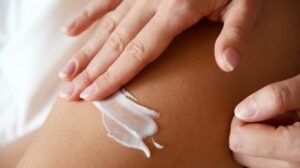Diabetic dermopathy, characterized by small, round, brownish lesions on the skin, particularly on the legs, is a common dermatological manifestation in diabetic patients. Although these lesions are usually harmless and painless, they can be a cosmetic concern for many. Understanding diabetic dermopathy is crucial for managing this condition effectively. In this comprehensive guide, we delve into the nature of the condition and discuss various diabetic dermopathy treatment options available to manage and alleviate its appearance.
Contents
Is Diabetic Dermopathy Harmful?
 Diabetic dermopathy, often referred to as “shin spots,” is generally considered a harmless condition. It is one of the most common cutaneous manifestations of diabetes, characterized by small, round, and slightly indented scaly patches on the skin, usually appearing on the shins. These lesions are the result of changes in the small blood vessels that supply the skin and are more a marker of diabetes and its duration rather than a direct cause of harm.
Diabetic dermopathy, often referred to as “shin spots,” is generally considered a harmless condition. It is one of the most common cutaneous manifestations of diabetes, characterized by small, round, and slightly indented scaly patches on the skin, usually appearing on the shins. These lesions are the result of changes in the small blood vessels that supply the skin and are more a marker of diabetes and its duration rather than a direct cause of harm.
They do not cause any pain or itchiness and typically do not require medical treatment. However, their presence can be a visual reminder of the underlying condition of diabetes and its potential complications if not properly managed. Despite being non-harmful in terms of physical health, diabetic dermopathy can have psychological or cosmetic concerns for some individuals.
The appearance of these lesions can be distressing, especially as they often do not heal completely and can be quite noticeable. This aspect underscores the importance of comprehensive diabetes management. As such, while diabetic dermopathy itself is not harmful, it serves as an important indicator for patients and healthcare providers to monitor and manage overall diabetes care effectively.
What Are The Best Diabetic Dermopathy Treatment?
The best approach to diabetic dermopathy treatment largely involves managing the underlying diabetes and maintaining overall skin health, as the condition itself is generally harmless and often does not require specific treatment. Here are some key strategies:
Optimal Diabetes Management
The cornerstone of treating diabetic dermopathy is the effective management of diabetes itself. This involves meticulous monitoring of blood glucose levels to keep them within target ranges, as recommended by healthcare professionals. Consistently high blood sugar levels can exacerbate skin problems and slow down the healing process of any lesions. Patients are advised to adhere strictly to their prescribed medication regimen, whether it involves oral hypoglycemic agents or insulin therapy.
Skin Care Regimen
The skin, particularly in areas like the shins where diabetic dermopathy often appears, can become extremely dry and susceptible to further injury. Using mild, hypoallergenic, and fragrance-free moisturizers can help keep the skin hydrated and prevent cracking or peeling. It’s also advisable to avoid hot showers and harsh soaps, which can strip natural oils from the skin, exacerbating dryness. Gentle cleansing and regular moisturizing can help maintain skin integrity and prevent additional complications.
Healthy Lifestyle Choices
 A diet rich in fruits, vegetables, whole grains, lean protein, and healthy fats can help regulate blood sugar levels and provide essential nutrients that promote skin health. Regular physical activity is another pillar of diabetes management, as it aids in blood sugar control, weight management, and overall well-being. Additionally, maintaining a healthy weight can reduce the risk of diabetes complications, including skin conditions. Adequate sleep and stress management are also important, as stress can negatively impact blood sugar levels and overall health.
A diet rich in fruits, vegetables, whole grains, lean protein, and healthy fats can help regulate blood sugar levels and provide essential nutrients that promote skin health. Regular physical activity is another pillar of diabetes management, as it aids in blood sugar control, weight management, and overall well-being. Additionally, maintaining a healthy weight can reduce the risk of diabetes complications, including skin conditions. Adequate sleep and stress management are also important, as stress can negatively impact blood sugar levels and overall health.
Protecting the Skin
For people with diabetic dermopathy, protecting the skin from injury is vital. The lesions themselves do not cause harm, but the skin in individuals with diabetes is more prone to injuries and infections. It’s important to wear appropriate and comfortable footwear to protect the feet from cuts and bruises, as foot complications are common in diabetes. The skin should also be protected from extreme temperatures, as both heat and cold can cause skin damage. Sun protection is equally important; using a broad-spectrum sunscreen can help protect the skin from harmful UV rays, preventing further damage and aging of the skin.
Cosmetic Treatments
While diabetic dermopathy is medically harmless, the cosmetic concerns it raises can be significant for some individuals. For those self-conscious about the appearance of these lesions, cosmetic options are available. Makeup or self-tanning products can be used to camouflage the spots. When choosing these products, it’s important to select those designed for sensitive skin to avoid irritation. Additionally, consulting with a dermatologist before using any new cosmetic product is advisable.
Avoiding Smoking
Smoking adversely affects blood circulation. This can exacerbate skin problems and impair wound healing. This is particularly crucial for individuals with diabetes, as they are already at an increased risk for circulatory issues. Smoking also contributes to the development of other diabetes-related complications, such as heart disease and peripheral vascular disease. Quitting smoking can significantly improve overall health, enhance blood flow, and thereby help in better management of skin conditions associated with diabetes.
Staying Hydrated
Hydration is key to maintaining healthy skin, especially for individuals with diabetic dermopathy. Adequate water intake ensures that the skin remains moisturized from the inside out, reducing dryness and promoting overall skin health. When the body is well-hydrated, the skin is more resilient and better able to resist irritations and infections. Drinking plenty of water throughout the day is a simple yet effective way to support skin health. Moreover, proper hydration aids in the regulation of blood sugar levels and supports other bodily functions.
Remember, while these strategies can help manage diabetic dermopathy, they should be part of a comprehensive diabetes care plan. It’s important to work closely with healthcare providers to determine the best approach for individual needs.
What Cream Is Good For Diabetic Dermopathy Treatment?
 For treating diabetic dermopathy, the primary goal is to maintain overall skin health and prevent further complications, as the lesions themselves typically do not require specific treatment. However, using appropriate creams can help manage the condition and improve the appearance of the skin. Here are some types of creams that are commonly recommended:
For treating diabetic dermopathy, the primary goal is to maintain overall skin health and prevent further complications, as the lesions themselves typically do not require specific treatment. However, using appropriate creams can help manage the condition and improve the appearance of the skin. Here are some types of creams that are commonly recommended:
- Moisturizing Creams: Keeping the skin well-moisturized is crucial. Look for creams that are specifically designed for sensitive or dry skin. Products containing ingredients like glycerin, hyaluronic acid, ceramides, or urea are beneficial as they help retain moisture in the skin.
- Emollients: These are effective in keeping the skin soft and smooth. Emollients fill in gaps between skin cells that are missing moisture. This helps to restore the skin barrier.
- Lanolin-Free Creams: For those who are sensitive to lanolin, lanolin-free options are available that can provide effective moisturization without irritating.
- Fragrance-Free and Hypoallergenic Creams: It’s important to avoid creams with fragrances or other potential irritants, as diabetic skin can be more prone to irritation and allergic reactions.
- Topical Steroids: In some cases, particularly if there’s inflammation or itching associated with the skin changes, a mild topical steroid may be prescribed by a healthcare provider. However, these should only be used under medical supervision.
- Healing Creams: Creams containing ingredients like aloe vera or allantoin can help soothe and heal the skin. These are particularly useful if there is any associated irritation or dryness.
Always remember, before starting any new cream or skincare product, it’s advisable to consult with a healthcare provider or a dermatologist, especially for those with diabetes, as their skin may react differently to certain products. Additionally, while these creams can help with skin health, controlling blood sugar levels remains the most important aspect of managing diabetic dermopathy.
Conclusion
In conclusion, diabetic dermopathy, a common skin condition associated with diabetes, is generally harmless and does not require specific treatment. However, effectively managing diabetes and maintaining good skin health are crucial. Diabetic dermopathy treatment involves controlling blood sugar levels, using suitable skin care products like moisturizing and hypoallergenic creams, adopting healthy lifestyle habits, protecting the skin, avoiding smoking, and staying hydrated.
Regular check-ups with healthcare providers are also important to monitor and manage both diabetes and its skin manifestations. Do you want to get rid of diabetes? Join our online diabetes treatment program and reverse Diabetes naturally through lifestyle changes such as a Personalized Diet plan, Exercise, Yoga, dieticians, and health coaches.

